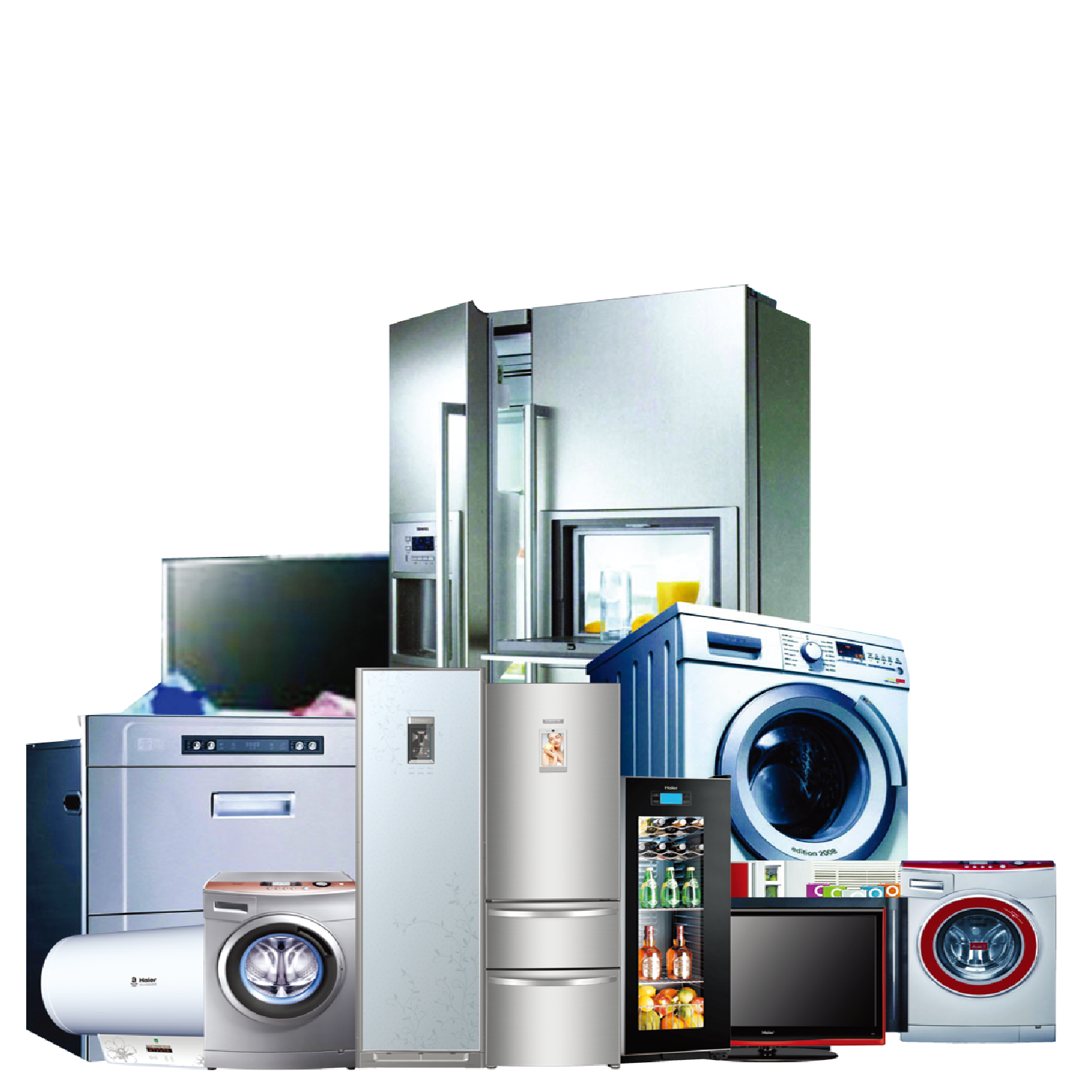Learn more about the Silverstone DS380B
| Brand | SilverStone |
|---|---|
| Model | DS380B |
| Type | NAS chassis |
|---|---|
| Color | Black |
| Case Material | Aluminum front door, SECC body |
| Power Supply | SFX PSU (sold separately) |
| Motherboard Compatibility | DTX, Mini-ITX |
| Dust Filters | Yes |
| External 3.5″ Drive Bays | 3.5” SAS/ SATA hot-swap x 8 (2.5” compatible) |
|---|---|
| Internal 2.5″ Drive Bays | 4 |
| Expansion Slots | 2 |
| Front Ports | USB 3.0 x 2 audio x 1 MIC x 1 |
|---|
| 120mm Fans | Rear: 1 x 120mm 1200rpm 22dBASide: Left — 2 x 120mm 1200rpm 22dBA |
|---|
| Max CPU Cooler Height | 57 mm |
|---|---|
| Dimensions (H x W x D) | 11.22″ x 8.31″ x 14.17″ |
| Features | Support 12 total drives with 8 hot-swappable 3.5” or 2.5” SAS/SATA and 4 fixed 2.5” drivesUnbelievable storage space and versatility for small form factorPremium brushed aluminum front doorSupport graphics card up to 11” with supporter design from TJ08-ELockable power button design and adjustable LED from GD07Includes three 120mm fans with filtered intake vents |
|---|
ASRock C2750D4I Motherboard / CPU
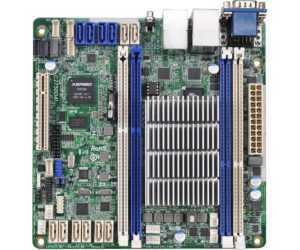
Update: 2014-05-11. Here’s a great video review on the motherboard…
12 SATA ports!This motherboard is perfect for ZFS which loves having direct access to JBOD disks. The Marvell SATA controllers did not show up in VMware initially, however Andreas Peetz provides a package for adding unsupported drivers in VMware, and this worked perfectly. It took me a couple minutes to realize all you need to do is run these three commands:
Update November 16, 2014 .. it turned out the below issue was caused by a faulty Marvell controller on the motherboard, I ran FreeBSD (a supported OS) and the fault also occurred there so I RMAed the motherboard … I ended up getting a bad motherboard again but after a second RMA everything is stable in VMware… so you can disregard the below warning.
Update March 12, 2015. My board continues to function okay, but some people are having issues with the drives working under VMware ESXi. Read the comments for details.
Update August 23, 2014 ** WARNING Read this before you run the command below ** I had stability issues using the below hack to get the Marvell controllers to show up. VMware started hanging as often as several times a day requiring a system reboot. This is the entry in the motherboard’s event log: Critical Interrupt – I/O Channel Check NMI Asserted. I swapped the Kingston memory out for Crucial on ASRock’s HCL list but the issue still persisted so I can’t recommend this drive for VMware. After heavy I/O tests ZFS also detected data corruption on two drives connected to the Marvell controllers. I am pretty sure this is because VMware does not officially support these drives so this issue likely doesn’t exist for operating systems that officially support the Marvell controller.
IPMI (allows for KVM over IP). After being spoiled by this on a Supermicro board IPMI with KVM over IP is a must have feature for me, I’ll never plug a keyboard and monitor into a server again.
Avoton Octa-Core processor. Normally I don’t even look at Atom processors, but this is not your grandfather’s Atom. The Avoton processor supports VT-x, ECC memory, AES instructions, and is a lot more powerful and at only 20 W TDP. This CPU Boss benchmark says it will probably perform similarly to the Xeon E3-1220L. The Avoton can also go up to 64GB memory where the E3 series is limited to 32GB making it a good option for VMware or for a high performance ZFS NAS. The Avoton does not support VT-d so there is no passing devices directly to VMs.
My only two disappointments are no internal USB header on the board (I always install VMware on a USB stick so right now there’s a USB stick hanging on the back) and I wish they had used SFF-8087 mini-SAS connectors instead of individual SATA ports on the board to cut down on the number of SATA cables.
Overall I am very impressed with this board and it’s server-grade features like IPMI.
Instead of going into more detail here, I’ll just reference Patrick’s review of the ASRock C2750D4I
Alternative Avoton Boards
There are a few other options worth looking at. The ASRock C2550D4I is the same board but Quad core instead of Octa Core. I actually almost bought this one except I got the 2750 at a good price on SuperBiiz.
Also the SuperMicro A1SAi-2750F (Octa core) and A1SAi-2550F (Quad core) are good options if you don’t need as many SATA ports or you’re going to use a PCI-E SATA/SAS controller. Supermicro’s motherboards have the advantage of Quad GbE ports, an internal USB header (not to mention USB 3.0), while sacrificing the number of SATA ports–only 2 SATA3 ports and 4 SATA2 ports. These Supermicro boards use the smaller SO-DIMM memory.
Silverstone DS-380: 8 hot-swap bay chassis
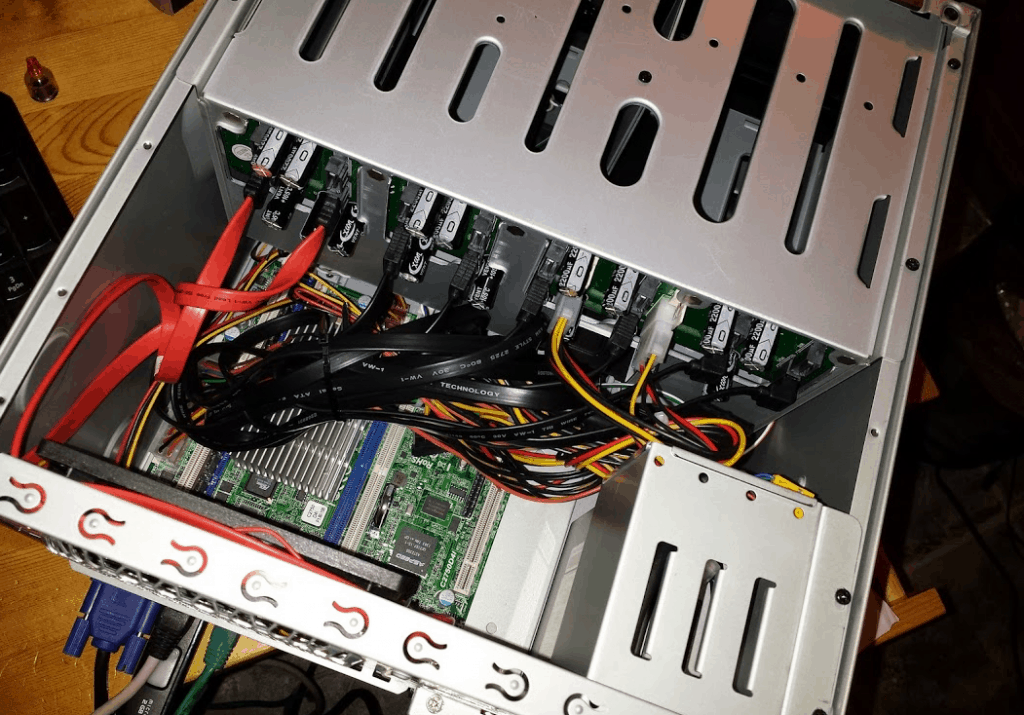
The DS-380 has 8 hot-swap bays, plus room for four fixed 2.5″ drives for up to 12 drives. As I started building this server I found the design was very well thought out. Power button lockout (a necessity if you have kids), locking door, dust screens on fan intakes, etc. The case is practical in that the designers cut costs where they could (like not painting the inside) but didn’t sacrifice anything of importance.
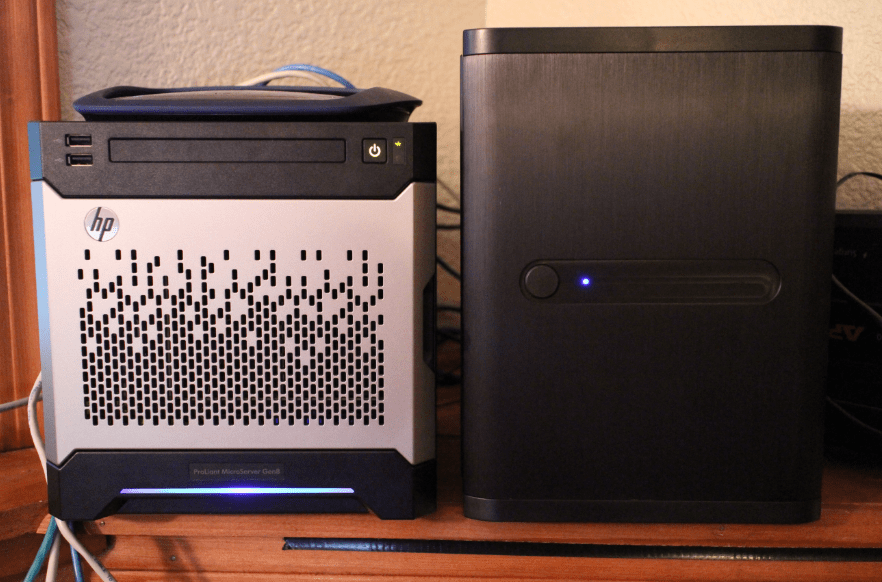 HP Gen 8 Microserver (Left) next to Silverstone DS-380 (right)
HP Gen 8 Microserver (Left) next to Silverstone DS-380 (right)
A little larger than the HP Gen8 Microserver, but it can hold more than twice as many drives. Also the Gen8 Microserver is a bit noisier.
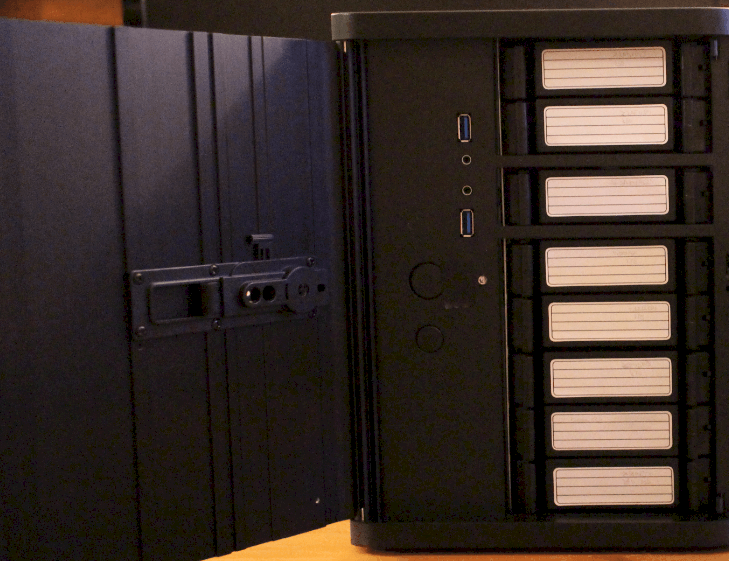
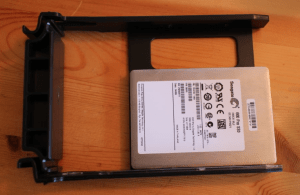
You’ll notice above from the top there is a set of two drives, then one drive by itself, and a set of five drives. This struck me as odd at first, but this is actually that way by design. If you have a tall PCI card plugged into your motherboard (such as a video card) you can forfeit the 3rd drive from the top to make room for it.
The drive trays are plastic, obviously not as nice as a metal tray but not too bad either. One nice feature is screw holes on the bottom allow for mounting a 2.5″ drive such as an SSD! That’s well thought out! Also there’s a clear plastic piece that runs alongside the left of each tray that carries the hard drive activity LED light to the front of the case (see video below).
Here’s the official Silverstone DS-380 site, and here’s a very detailed review of the DS-380 with lots of pictures by Lawrence Lee.
INTRODUCTION
For users migrating to small form factor (SFF) computers with large libraries of media files, storage capacity is often a compromise that is difficult to overcome. Choosing a smaller case may require additional purchase of external storage enclosure, while choosing a larger case with extra drive bays may defeat the purpose of going SFF in the first place.
To fulfill the needs of enthusiasts looking for a no compromise SFF media box, SilverStone designed a cutting edge product, the DS380. With the ability to accommodate standard components such as Mini-ITX motherboards, standard-length dual slot expansion card, and entry-level liquid CPU cooling system, the DS380 can easily handle high end system based on CPU with 95W TDP or above. Equipped with two 120mm intake fans and one 120mm exhaust fan plus externally removable filters on its top and side, keeping everything cool and dust-free is as easy as in any SilverStone premium chassis. Notable features from SilverStone’s famed HTPC cases were also included such as LED indicator with adjustable brightness and lockable front door and power button.
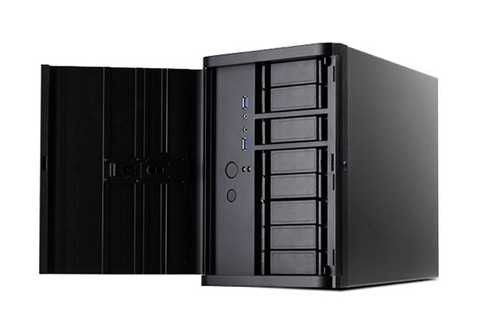
Completing what is an impressive SFF case is DS380’s signature feature: a modular eight hot-swappable drive cage design that supports both 3.5″ and 2.5″ drives. It utilizes a custom, back-panel PCB designed to support both SATA and SAS interface for increased compatibly with nearly all modern hard drives or SSDs. At only 21 liters overall, the impressively small DS380 is perfect for anyone looking to build a powerful SFF NAS for home or office.
SPECIAL FEATURES
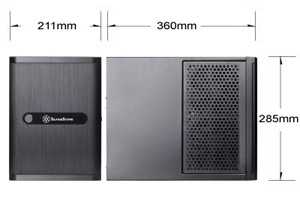
- Supports 12 total drives with 8 hot-swappable 3.5″ or 2.5″ SAS/SATA and 4 fixed 2.5″ drives
- Unbelievable storage space and versatility for small form factor
- Premium brushed aluminum front door
- Support graphics card up to 11″ with supporter design from TJ08-E
- Lockable power button design and adjustable LED from GD07
- Includes three 120mm fans with filtered intake vents
FEATURE PHOTOS
Lockable power button design and adjustable LED
Hot-swappable 3.5
Front I/O Port
Filtered intake vents
Magnetic filter for easy-cleaning
Lockable front door
Keys for front door lock
Power button lock
2 x 120mm intake fan
1 x 120m fans in the Rear
High-quality foot pads
Specifications
| Model No. | SST-DS380B (black) |
| Materials | Aluminum front door, SECC body |
| Motherboards | DTX, Mini-ITX |
| External Drive Bays | 3.5″ SAS / SATA hot-swap x 8 (2.5″ compatible) |
| Internal Drive Bays | 2.5″ x 4 |
| Cooling Systems | Left Side:2 x 120mm 1200RPM 22dBA Rear:1 x 120mm 1200RPM 22dBA |
| Expansion Slots | 2 |
| Front I/O Ports | USB 3.0 x 2 audio x 1 MIC x 1 |
| Power Supply | 1 x Optional standard SFX |
| Max. PSU Size | 2.25in. (57mm) |
| Dimensions (W x H x D) | 8.3 x 11.2 x 14.2 inches (211 x 285 x 360mm), 1318.11 cu. in. (21.6 liters) |
| Volume | 1318.11 cu. in. (21.6 liters) |
| Extra | Kensington Lock |
Storage
Using 4TB drives 8 bays would get you to 24TB using RAID-Z2 or RAID-6. Plus have 4 2.5″ fixed bays left for SSDs.
Virtual NAS
I run a virtualized ZFS server on OmniOS following Gea’s Napp-in-one guide. I deviate from his design slightly because I run on top of VMDKs instead of Passing the controllers to the guest VM (because I don’t have VT-d on the Avoton).
ZIL – Seagate SSD Pro
120GB Seagate Pro SSD. The ZIL (ZFS Intent Log) is the real trick to high performance random writes, by being able to cache writes on capacitor backed cache the SSD can guarantee a write to the requesting application before it is transferred out of RAM and onto spindles.
